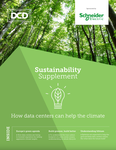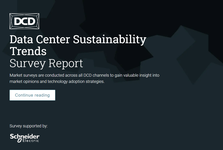The recent COP26 conference in Glasgow, UK made it plain: every organization has to come up with a plan to reach net zero carbon emissions to keep warming within 1.5 Celsius. Achieving this goal will mean virtually retrofitting every aspect of our economy for greater efficiency and renewable sources of power.
How does computing stack up? Cloud computing had a remarkable run in the 2010s. At that time, many corporations were just emerging from their first beta tests. Some IT decision-makers in a poll ranked cloud as the most overhyped technology. Netflix had just launched its first streaming-only accounts.
Not only have businesses moved email to the cloud, energy companies and manufacturers are moving critical systems for production there too. Video accounts for 80 percent+ of Internet traffic. Data center traffic has grown by 8x while the worldwide stock of data center floor space has more than doubled to over 200 million square feet.
But what hasn’t changed? Energy consumption. Although data center power consumption nearly doubled from 2000 to 2010, it only rose from 194 terawatt-hours (TWh) in 2010 to 200 TWh in 2019 despite the tsunami of adoption.
Now the hard part
What happened? In the late 2000s, cloud providers and data center owners became alarmed about energy consumption—one of their largest operating expenses—and started consolidating workloads to improve overall efficiency. Some took an even simpler route and let their facilities run hotter. It worked. The average Power Use Effectiveness, a measure of the power that runs computing equipment instead of air conditioning in a data center, has dropped from 2.5 to 1.59. (Lower is better.) In some cutting-edge data centers, it’s nearing an ideal 1.0.
Unfortunately, keeping data center power consumption flat in the 2020s will be more difficult. Demand for digital services is accelerating, fueled by advances in AI, 5G, and IoT. Emerging economies are building out their digital infrastructures to get the 3.7 billion people who’ve been left out of the digital revolution online All of this activity has to be accommodated, but not at the expense of the planet. Meanwhile, a good portion of the low-hanging fruit is approaching its limits. You can only unplug a zombie server once.
Some predict data center power consumption could grow by 2x to 7x without substantial innovation.
Even with more investments in wind and solar, data center emissions would likely rise. It would also undermine the business model of the cloud. If energy consumption rises, costs rise. If costs rise, demand could slow. Regional governments are also imposing stricter limits on data center power and water consumption.
Inside the box
So what can we do? Think inside the box by starting to reimagine and redesign the core components of computing to increase performance per watt and eliminate inefficiencies that weren’t possible or practical before.
Take CPUs for example. Until recently, traditional architectures were the only choice. Now, cloud service providers like Amazon Web Services, Oracle, Tencent, Alibaba, and others are adopting Arm-based processors, which are optimized for performance per watt. Cloudflare, a service provider that serves 1/6th of the world’s websites, has said it can perform 57 percent more operations within the same energy budget switching from traditional processors to Arm Neoverse-based processors.
Increasingly, acceleration is being deployed to deliver disruptive performance or efficiency. Data Processing Units (DPUs), Neural Processing Units (NPUs), and other specialized processors are becoming more prevalent for more efficiently processing networking, security, and storage tasks, lowering cost and power consumption at the same time.
Most of these accelerators require a certain amount of compute support to run firmware, OS, control plane, or other runtimes to feed the accelerator functions. Traditionally, this compute was delivered using power-hungry legacy processors with the accelerator handled over PCIE but this is changing to more on-chip or in-package heterogeneity where IP cores can be leveraged to provide compute cycle support. Google, for instance, recently announced it is developing processors containing Arm technology for these tasks into its cloud operations as admin tasks can soak up to 80 percent of CPU cycles across a range of microservices.
Beyond the processors
Some estimate that data movement accounts for over 60 percent of system energy. This has driven innovation in disaggregation of storage and memory. In order to drive more efficient use of expensive and power-hungry memory, companies are innovating in ways that allow the memory and storage to be leveraged across multiple compute nodes. Down the road, technologies like computational storage—where basic processing is performed by CPUs tucked inside SSDs—and advanced interconnects will be adopted to cut down on data traffic.
Chiplets and 3D packaging likewise could a similar effect: expect to see designs where a single device will consist of tens, and later hundreds, of CPU, GPU, and NPU cores are linked to massive, shared arrays of SRAM and DRAM. If designed carefully, chiplets could improve performance per watt while increasing the computing power capable of being inserted into space-constrained environments in medical diagnostic equipment or cars.
You’ll see improvements elsewhere as well. Last year, MIT researchers found that building computer vision neural network models with pre-trained subnetworks can get results with 1/1,300th of the carbon. Rolling workloads between data centers in different locations to capitalize on available renewables will also become more prevalent.
The fight for a sustainable world
Data centers are one of the key tools in the fight against climate change. Digital technologies hold the potential to reduce worldwide emissions by 15 percent by 2030, or nearly 1/3 of the target set by the United Nations, by helping manufacturers and REITs fine tune real-world activities. Further gains in emissions with digital technologies will be made in the 2030s and 2040s as other industries like farms and transportation more intensely cloudify their operations. We have an obligation to do this.





